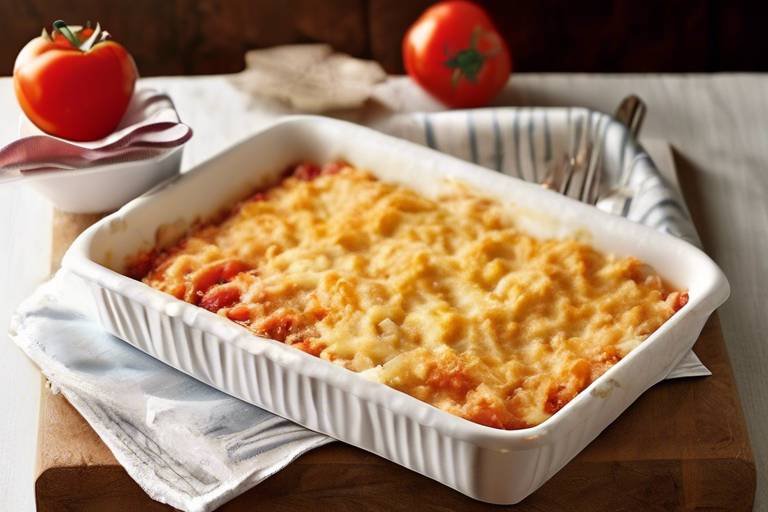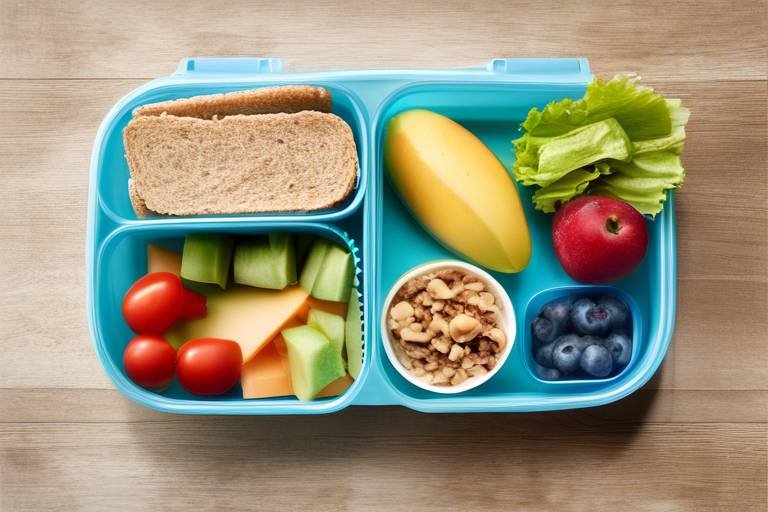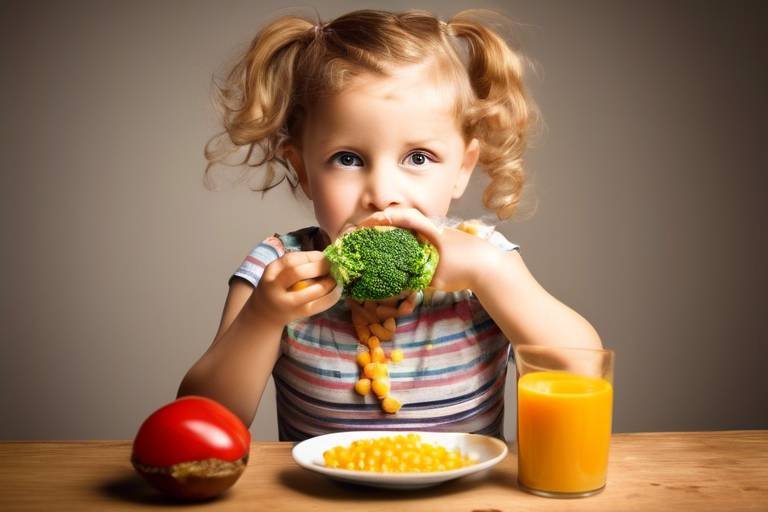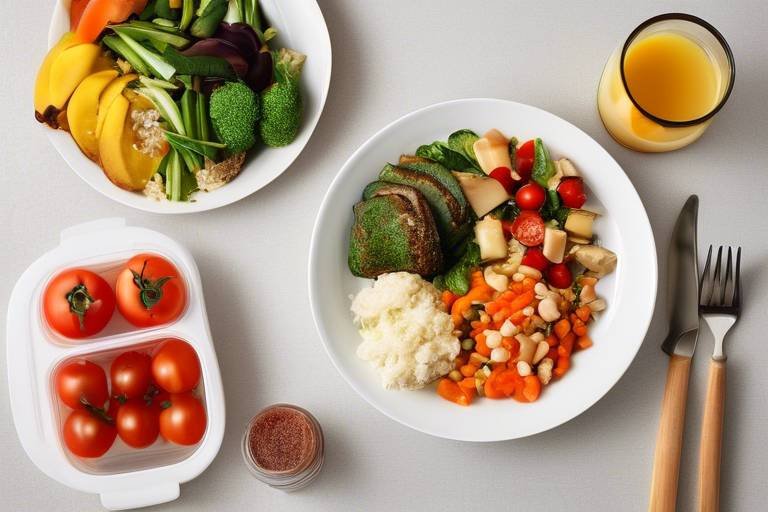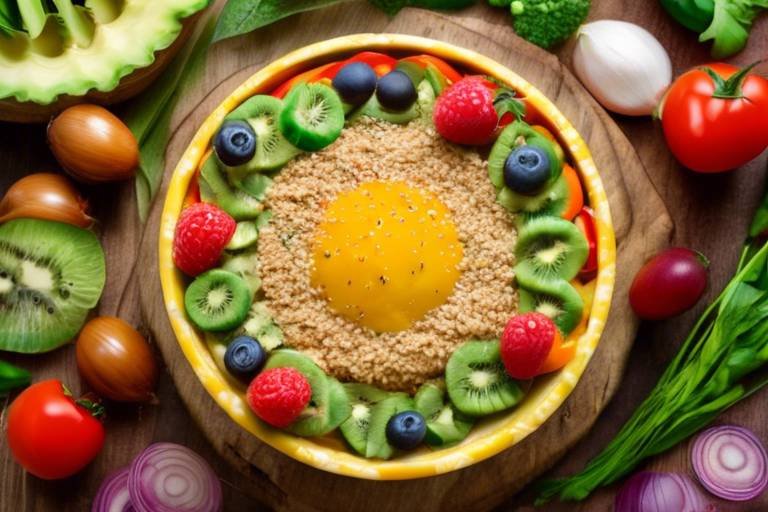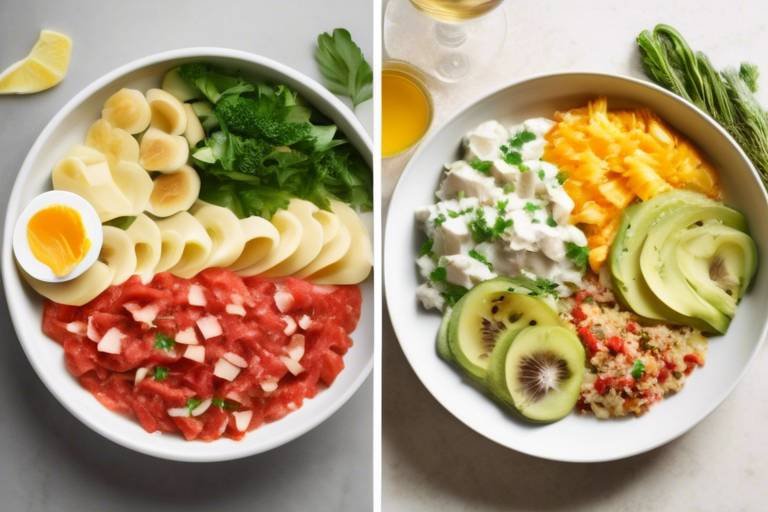Tips for Encouraging Healthy Eating Habits in Teens
Encouraging healthy eating habits in teenagers can feel like trying to navigate a minefield; it’s tricky, and one wrong step can lead to a whole lot of frustration! But don't worry—this article is your roadmap to fostering a balanced diet among your teens. As they grow and develop, teenagers face unique nutritional needs that can sometimes clash with their preferences for fast food and sugary snacks. So, how can parents and caregivers step in to promote healthier choices without sounding like a broken record? Let’s dive into some practical strategies that can make a real difference!
During the teenage years, the body undergoes significant changes, which means that nutritional needs are at an all-time high. Teens require a mix of essential nutrients to support their growth, energy levels, and overall well-being. Key nutrients include:
- Protein: Crucial for growth and muscle development.
- Calcium: Important for bone health, as bones are still growing.
- Iron: Essential for energy and to prevent anemia, especially in active teens.
- Vitamins and Minerals: Vital for various bodily functions, including immune health.
So, what does a balanced diet look like for a teenager? It’s all about incorporating a variety of foods from all food groups, including fruits, vegetables, whole grains, lean proteins, and healthy fats. By understanding these needs, parents can better guide their teens toward healthier choices.
One of the best ways to encourage healthy eating is to involve teens in meal planning. When they have a hand in choosing what to eat, they’re more likely to be interested in trying new foods. Start by having regular family meetings where everyone can share their favorite meals or snacks. This not only fosters communication but also empowers teens to take ownership of their dietary choices.
Once you’ve got your meals planned, it’s time to hit the grocery store. A well-structured grocery list is key to making healthier choices. Here are some tips for creating a balanced grocery list:
- Include a variety of fruits and vegetables—aim for color and diversity!
- Choose whole grains like brown rice and whole wheat bread.
- Opt for lean proteins such as chicken, fish, and legumes.
- Don’t forget healthy fats from sources like avocados and nuts.
By having a list that reflects a range of nutritious options, you’re setting your teen up for success in the kitchen!
When it comes to nutrition, whole foods are your best friends. These are foods that are minimally processed and packed with nutrients. Think fresh fruits, vegetables, whole grains, and lean proteins. On the other hand, processed foods often contain added sugars, unhealthy fats, and preservatives that can negatively impact health. Encourage your teen to make the switch by explaining the benefits of whole foods:
- Better Nutrient Density: Whole foods are rich in vitamins and minerals.
- Improved Energy Levels: They provide sustained energy without the crash.
- Enhanced Mood: A balanced diet can positively affect mental health!
Let’s face it: eating the same thing every day can be boring! To keep meals exciting, incorporate fun and variety into your teen's diet. Experiment with different cuisines, try new recipes, or even have themed dinner nights where everyone can contribute. Think taco night, sushi-making parties, or smoothie challenges! The more variety you introduce, the more likely your teen will be to explore new flavors and textures.
As a parent or caregiver, you play a crucial role in shaping your teen's eating habits. If they see you indulging in healthy foods and making nutritious choices, they’re likely to follow suit. It’s all about leading by example! Share your own food experiences, whether it’s trying a new salad recipe or enjoying a homemade smoothie. When teens see you enjoying healthy foods, they’ll be more inclined to do the same.
Let’s face it—teens face a myriad of challenges that can hinder healthy eating. From peer pressure to busy schedules, it can feel overwhelming. But don’t fret! By identifying these obstacles and offering practical solutions, you can help your teen maintain a balanced diet.
Peer influence can be a double-edged sword when it comes to food choices. Encourage your teen to make independent decisions by discussing the importance of nutrition and how it affects their performance in sports, school, and daily life. Remind them that it’s okay to say no to unhealthy snacks when their friends offer them. Empowering them with knowledge can help them navigate these situations with confidence.
With busy schedules packed with school, activities, and social events, it can be hard for teens to prioritize healthy eating. Help them manage their time by planning quick and nutritious meals. Think meal prep on weekends, easy-to-assemble snacks, and simple recipes that can be whipped up in under 30 minutes. The key is to make healthy eating convenient and accessible, even on the busiest of days!
Q: What are some quick healthy snack ideas for teens?
A: Some quick snacks include Greek yogurt with fruit, hummus with veggies, or whole-grain crackers with cheese.
Q: How can I get my teen to try new foods?
A: Encourage them to join in cooking and experimenting with new recipes. Make it a fun family activity!
Q: What should I do if my teen refuses to eat vegetables?
A: Try different cooking methods or incorporate veggies into their favorite dishes. Sometimes, a little creativity can go a long way!

Understanding Teen Nutritional Needs
Teenagers are not just mini-adults; they are in a phase of rapid growth and development that requires special attention to their nutritional needs. During these formative years, their bodies are changing at a remarkable pace, and with that comes a unique set of dietary requirements. It's crucial for parents and caregivers to understand what nutrients are essential for supporting their health.
First off, let’s talk about calories. Teenagers need more calories than younger children or adults because they are growing and often very active. On average, teenage boys require about 2,800 calories a day, while teenage girls need around 2,200 calories. However, these numbers can vary based on individual activity levels and metabolic rates.
Next, let’s dive into the nutrients that should be prioritized in a teen's diet. Here’s a quick rundown:
- Proteins: Essential for growth, repair, and overall health. Sources include lean meats, dairy, beans, and nuts.
- Carbohydrates: The body’s main source of energy. Whole grains, fruits, and vegetables should be the go-to options.
- Fats: Healthy fats from sources like avocados, nuts, and olive oil are important for brain development.
- Vitamins and Minerals: Calcium and vitamin D are crucial for bone health, while iron is essential for energy levels, especially in girls who may experience menstruation.
In addition to these nutrients, hydration is often overlooked but is equally essential. Teens should aim to drink plenty of water throughout the day, particularly if they are involved in sports or other physical activities. A good rule of thumb is to drink at least 8-10 cups of water daily, but this can increase with exercise.
Moreover, balancing meals is key. Each meal should ideally consist of a mix of proteins, carbohydrates, and fats, along with plenty of fruits and vegetables. This not only ensures that teens get the necessary nutrients but also helps them feel full and satisfied. Think of it like building a strong house; you need a solid foundation (proteins), sturdy walls (carbohydrates), and a roof (fats) to keep everything protected and functional.
Understanding these nutritional needs is the first step in guiding teens toward healthier eating habits. By providing them with the right information and resources, parents can empower their teenagers to make informed choices that will benefit them throughout their lives.

Involving Teens in Meal Planning
Engaging teens in meal planning is not just about getting them to choose what’s for dinner; it’s about empowering them to take control of their own nutrition. When teenagers are involved in the process, they’re more likely to make healthier choices, understand the importance of balanced meals, and even develop a passion for cooking. Think of it as giving them the keys to a car—they're more likely to drive safely if they know how the vehicle works! So, how can we encourage this level of involvement? Let's explore some practical strategies.
First off, make meal planning a family affair. Set aside a specific time each week to sit down together and discuss what everyone would like to eat. This not only fosters communication but also allows teens to express their preferences. You can create a fun environment by using colorful markers or a whiteboard to jot down ideas. By involving them in this creative process, you’re not just making a grocery list; you’re making it a collaborative project. This way, teens feel valued and heard, which can significantly increase their interest in the meals being prepared.
Another effective strategy is to introduce them to the concept of balanced meals. Educate them about the different food groups, and why it's essential to include a variety of nutrients in their diets. You can create a simple table together that outlines what a balanced plate looks like:
| Food Group | Examples | Serving Size |
|---|---|---|
| Fruits | Apples, Bananas, Berries | 1 cup |
| Vegetables | Broccoli, Carrots, Spinach | 1 cup (raw) or 1/2 cup (cooked) |
| Grains | Brown Rice, Quinoa, Whole Wheat Bread | 1/2 cup (cooked) or 1 slice |
| Protein | Chicken, Beans, Tofu | 3 oz (cooked) |
| Dairy | Milk, Yogurt, Cheese | 1 cup |
By having this visual aid, teens can better understand how to build their meals. Plus, it encourages them to think critically about what they’re putting on their plates. You could even challenge them to create a meal that meets these guidelines. This not only makes it educational but adds an element of fun!
Don’t forget about the cooking aspect! Encourage teens to participate in the actual preparation of meals. This can be a great bonding experience, and it’s also an excellent way for them to develop valuable life skills. Start with simple recipes that they can help with, gradually moving on to more complex dishes as they gain confidence. You might be surprised at how much they enjoy it! It’s like giving them a treasure map to discover new flavors and techniques in the kitchen.
Lastly, be sure to celebrate their efforts. Whether it’s a successful meal or simply trying something new, acknowledgment goes a long way. This boosts their confidence and reinforces the idea that healthy eating can be both enjoyable and rewarding. After all, who doesn’t love a little praise for a job well done?
In conclusion, involving teens in meal planning is a dynamic way to promote healthy eating habits. It’s about teaching them to take charge of their nutrition while making the process enjoyable and educational. So, roll up your sleeves, grab those ingredients, and let’s get cooking!
- Why is it important to involve teens in meal planning?
Involving teens helps them make healthier choices, understand nutrition better, and develop cooking skills. - How can I encourage my teen to try new foods?
Make it a fun exploration! Introduce new foods gradually and involve them in cooking to pique their interest. - What if my teen is picky about food?
Be patient. Offer a variety of options and let them choose what they want to try. Encourage them to be part of the decision-making process.

Creating a Balanced Grocery List
When it comes to promoting healthy eating habits in teens, one of the most effective tools at your disposal is a well-structured grocery list. Think of it as your roadmap to a nutritious diet! A balanced grocery list not only ensures that you have a variety of healthy options at home, but it also encourages teenagers to make better food choices. So, how do you create this all-important list? Let's break it down.
First and foremost, it's essential to include a mix of food groups to meet the nutritional needs of growing teens. This means incorporating:
- Fruits and Vegetables: Aim for a colorful selection. The more colors you have, the more nutrients you’re likely to include!
- Whole Grains: Look for brown rice, whole wheat bread, and oats. These provide energy and are packed with fiber.
- Proteins: Include lean meats, fish, eggs, beans, and nuts. Protein is vital for growth and muscle development.
- Dairy or Dairy Alternatives: Choose low-fat milk, yogurt, or fortified plant-based options for calcium and vitamin D.
Next, consider involving your teen in the grocery shopping process. This can be a fun bonding experience and gives them a sense of ownership over their food choices. Ask them to pick out their favorite fruits or suggest new vegetables to try. This not only makes them more likely to eat what they help choose, but it also opens up discussions about nutrition and healthy eating.
Another tip for creating a balanced grocery list is to plan meals for the week ahead. By doing this, you can ensure that you have all the necessary ingredients on hand and reduce the temptation to resort to unhealthy convenience foods. A simple meal plan can look like this:
| Day | Meal | Key Ingredients |
|---|---|---|
| Monday | Grilled Chicken Salad | Chicken, mixed greens, cherry tomatoes, avocado |
| Tuesday | Vegetable Stir-fry | Broccoli, bell peppers, tofu, brown rice |
| Wednesday | Whole Wheat Pasta | Pasta, marinara sauce, spinach, parmesan |
| Thursday | Taco Night | Ground turkey, whole wheat tortillas, lettuce, salsa |
| Friday | Homemade Pizza | Whole wheat dough, tomato sauce, mozzarella, assorted toppings |
Lastly, don’t forget to keep it fun! Encourage your teen to try new foods and flavors. Perhaps add a section to your grocery list labeled “Try Something New” where they can suggest items they’ve seen on social media or heard about from friends. This not only keeps meals exciting but also helps them develop a more adventurous palate.
In conclusion, creating a balanced grocery list is a powerful way to encourage healthy eating habits among teens. By involving them in the process, planning meals together, and keeping things varied and fun, you can help set them on a path to a lifetime of nutritious choices. Remember, it’s all about balance and making healthy eating an enjoyable part of their daily lives!
Q: How can I get my teen to eat more fruits and vegetables?
A: Try making fruits and veggies more accessible by keeping them washed and cut in the fridge. Incorporating them into smoothies or fun recipes can also pique their interest!
Q: What if my teen refuses to eat healthy foods?
A: Patience is key! Encourage them to try new foods without pressure. Sometimes, it takes multiple exposures before they’re willing to give something a shot.
Q: How can I make grocery shopping more enjoyable for my teenager?
A: Turn it into a fun outing! Play games, like seeing who can find a specific item first, or let them pick out a new snack to try.

Choosing Whole Foods Over Processed
When it comes to nourishing our bodies, the choice between whole foods and processed foods can significantly impact our health, especially during the teenage years. Whole foods, which include fresh fruits, vegetables, whole grains, nuts, and seeds, are packed with essential nutrients that support growth, energy levels, and overall well-being. On the other hand, processed foods often come with a laundry list of additives, preservatives, and unhealthy fats that can undermine a teen's health.
One of the easiest ways to encourage teens to choose whole foods is to make them aware of the benefits. For instance, whole foods are generally more nutrient-dense, meaning they provide more vitamins and minerals per calorie compared to their processed counterparts. This is crucial for teenagers who are still growing and require a variety of nutrients to support their development. Eating a diet rich in whole foods can lead to improved concentration, better mood regulation, and higher energy levels, which are all essential for academic performance and social interactions.
Moreover, the allure of processed foods often lies in their convenience and taste. However, it's important to challenge this notion by showing teens how easy and fun it can be to prepare meals using whole ingredients. For example, instead of reaching for a frozen pizza, why not create a homemade pizza using whole grain dough, fresh vegetables, and lean proteins? This not only tastes better but also provides a sense of accomplishment that can encourage teens to explore cooking as a hobby.
Here are some practical tips for integrating whole foods into a teenager's diet:
- Shop Together: Involve your teen in grocery shopping and teach them how to read labels. Show them how to identify whole foods and discuss why they are better choices.
- Cooking Classes: Consider enrolling your teen in a cooking class that focuses on healthy cooking techniques using whole ingredients. This can be a fun way to learn and bond.
- Creative Substitutions: Encourage teens to experiment with alternatives to their favorite processed snacks. For instance, swap out chips for air-popped popcorn or fresh veggie sticks with hummus.
Ultimately, making the switch from processed to whole foods doesn’t have to be a daunting task. By introducing a variety of colorful, flavorful, and nutritious options, you can help foster a positive relationship with food that lasts a lifetime. Remember, it's not just about making changes; it's about creating an environment where healthy choices are the norm, making it easier for teens to thrive.
Q: What are some examples of whole foods?
A: Whole foods include fresh fruits, vegetables, whole grains (like brown rice and quinoa), nuts, seeds, legumes, and unprocessed meats and dairy products.
Q: Why are processed foods bad for teens?
A: Processed foods often contain high levels of sugar, unhealthy fats, and additives that can lead to weight gain, energy crashes, and other health issues, which are particularly concerning during the growth spurts of adolescence.
Q: How can I encourage my teen to eat more whole foods?
A: Involve them in meal planning and preparation, educate them on the benefits of whole foods, and provide a variety of delicious options to choose from. Making healthy eating fun and engaging can significantly increase their willingness to try new foods.

Incorporating Fun and Variety
When it comes to healthy eating, variety is the spice of life, especially for teenagers! Imagine trying to eat the same meal every day; it would get boring, right? Well, the same goes for our teens. To keep them excited about their meals and encourage them to make healthier choices, it's essential to incorporate fun and variety into their diets. One effective way to do this is by introducing a rainbow of colorful fruits and vegetables. Not only do they look appealing on the plate, but they also provide a wide range of nutrients that are crucial for a growing body.
Another way to add excitement to meals is by experimenting with different cuisines. Why not take a culinary trip around the world right from your kitchen? You could try making Mexican tacos one night, followed by a Japanese sushi night the next. This not only broadens their palate but also makes meals an adventure. You can even involve your teens in the cooking process. Let them choose a recipe from a different culture and help prepare it. This hands-on approach can spark their interest in healthy eating.
It’s also important to incorporate fun themes into meals. For instance, you could have a “Build Your Own Bowl” night where everyone can customize their meals with a variety of healthy toppings. Think of it like a salad bar but with more options! You could offer whole grains like quinoa or brown rice, an array of proteins like grilled chicken or chickpeas, and a selection of colorful veggies and dressings. This not only makes the meal interactive but also empowers teens to make choices that align with their health goals.
Moreover, don’t forget about snacks! Healthy snacking can be a fun part of their day. Consider setting up a snack station in the kitchen with a variety of healthy options. You can include things like hummus and veggies, yogurt with fruit, or whole grain crackers with cheese. When teens have easy access to healthy snacks, they’re less likely to reach for junk food. Plus, having a visually appealing snack station can make healthy eating feel less like a chore and more like a treat!
In conclusion, incorporating fun and variety into meals is not just about making food more enjoyable; it's about creating a positive relationship with food that encourages lifelong healthy habits. By engaging teens in meal preparation, introducing new cuisines, and offering customizable meal options, parents can foster an environment where healthy eating is both exciting and rewarding.
- How can I encourage my teen to try new foods?
Introduce new foods gradually and pair them with familiar favorites. Make it a fun experience by cooking together or visiting a local farmer's market. - What are some quick healthy snacks for teens?
Some great options include yogurt with fruit, whole grain toast with avocado, or homemade trail mix with nuts and dried fruits. - How can I make healthy meals more appealing?
Use colorful ingredients, involve your teen in meal prep, and create themed dinner nights to keep things exciting.

Setting a Positive Example
When it comes to shaping the eating habits of teenagers, parents and caregivers are the ultimate role models. It's not just about telling them what to eat; it's about showing them how to embrace a healthy lifestyle. Think of it like this: if you want your teen to thrive on a balanced diet, you need to be the walking, talking example of that lifestyle. Your behavior can either inspire or discourage them, so why not choose to inspire?
One of the most effective ways to set a positive example is by making healthy eating a family affair. This means not only preparing nutritious meals but also sitting down together to enjoy them. When teens see their parents choosing fruits over chips or opting for water instead of soda, they’re more likely to mirror those choices. It’s like a ripple effect—your habits can create waves of change in their eating behaviors.
Moreover, it’s essential to incorporate variety and excitement into your meals. If you’re constantly serving the same old dishes, your teen might start to view healthy eating as boring. Instead, try experimenting with new recipes or cuisines. For example, consider introducing a “theme night” each week, such as Taco Tuesday or Stir-Fry Saturday, where everyone can participate in the cooking process. This not only makes meals more enjoyable but also teaches them about diverse ingredients and cooking techniques.
Another crucial aspect is to maintain a positive attitude towards food. Avoid labeling foods as “good” or “bad.” Instead, focus on the idea of balance. You might say, “We can enjoy pizza on Friday nights, but let’s make sure we load it up with veggies!” This approach helps teens develop a healthy relationship with food, where they learn to appreciate moderation rather than restriction.
Additionally, consider sharing your own health and wellness journey with your teens. Discuss your goals, the challenges you face, and the victories you celebrate. This openness can foster a sense of camaraderie and encourage them to pursue their own health goals. Remember, it’s not just about the food on the table; it’s about the conversations and connections that happen around it.
Lastly, don't forget to involve your teens in the decision-making process regarding meals. Ask for their input when planning the week’s menu or grocery shopping. This not only empowers them but also makes them feel valued. When they have a say in what’s being eaten, they’re more likely to embrace those choices. So, roll up your sleeves and make healthy eating a family mission—the benefits will be well worth the effort!
- How can I get my teen interested in cooking? Start with simple recipes that they can relate to, and gradually introduce more complex dishes as they gain confidence.
- What if my teen refuses to eat healthy foods? Encourage them to try new foods without pressure. Sometimes, it takes multiple exposures to a new food before they accept it.
- How can I maintain a healthy diet while managing a busy schedule? Plan meals in advance, prepare batch meals, and keep healthy snacks on hand for those hectic days.

Addressing Common Challenges
When it comes to promoting healthy eating habits in teens, it's crucial to recognize the common challenges they face. Adolescence is a time filled with changes, and many factors can influence a teen's dietary choices. From peer pressure to busy schedules, these hurdles can make it difficult for them to maintain a balanced diet. But fear not! With the right strategies, parents and caregivers can help their teens navigate these challenges successfully.
One of the most significant issues teens encounter is peer pressure. It's no secret that friends can have a huge impact on the choices teens make, especially regarding food. Imagine a scenario where a group of friends opts for fast food after school; the pressure to conform can lead a teen to make unhealthy choices, even if they know better. To combat this, it’s essential to equip teens with the skills to make informed decisions. Encourage open discussions about nutrition and empower them to stand firm in their choices. Role-playing different scenarios can also help them practice saying no to unhealthy options when they’re out with friends.
Another challenge is the time constraints that come with a busy teenage lifestyle. Between school, extracurricular activities, and social commitments, finding time to prepare healthy meals can feel like a daunting task. However, with a little creativity and planning, it’s entirely possible to fit nutritious eating into their hectic schedules. For instance, consider preparing meals in advance during the weekends. This way, teens can simply grab a healthy option when they’re on the go. Here are a few quick meal ideas that can be prepped ahead of time:
- Overnight oats with fruits and nuts for a quick breakfast.
- Wraps filled with lean protein and fresh veggies for lunch.
- Frozen smoothies that can be blended in minutes for a nutritious snack.
Additionally, keep healthy snacks readily available at home. Stocking up on fruits, nuts, and yogurt can help curb unhealthy cravings when teens are feeling hungry but pressed for time.
It's also essential to create an environment that encourages healthy eating. If junk food is readily available, it’s likely to be consumed more often. Instead, fill the pantry with wholesome options and involve teens in the process. This could mean letting them choose snacks they enjoy that are also healthy, like popcorn, whole-grain crackers, or hummus with veggies. By making healthy choices more accessible, you increase the likelihood of them opting for nutritious options.
Lastly, don’t underestimate the power of communication. Regularly check in with your teen about their eating habits and any challenges they might be facing. This creates a supportive atmosphere where they feel comfortable discussing their struggles. Whether it’s the allure of fast food or the temptation to skip meals, having open conversations can help you guide them toward healthier choices.
Q: How can I encourage my teen to eat healthier without being too controlling?
A: It's all about balance. Instead of dictating what they should eat, involve them in the process. Let them choose healthy options at the grocery store and encourage them to help in meal preparation. This way, they feel empowered rather than restricted.
Q: What are some quick and healthy snacks for teens?
A: Great options include yogurt with fruit, nut butter on whole-grain toast, trail mix, and veggie sticks with hummus. These snacks are not only nutritious but also easy to grab when they're on the go!
Q: How can I help my teen deal with peer pressure regarding food choices?
A: Encourage your teen to communicate their dietary preferences confidently. Role-playing scenarios can help them practice responding to peer pressure, and discussing the importance of making healthy choices can reinforce their resolve.

Dealing with Peer Pressure
Navigating the tumultuous waters of adolescence can be quite a challenge, especially when it comes to food choices. Peer pressure is a powerful force, often leading teens to make choices that don’t align with their health goals. Imagine a scenario where your teen is at a friend's birthday party, surrounded by pizza, soda, and cake. The temptation to indulge can be overwhelming, and it’s easy to see how they might choose to follow the crowd rather than stick to healthy eating habits. So, how can we help our teens stand strong against this pressure?
First and foremost, it’s essential to have open conversations about the impact of peer pressure on food choices. Discussing these experiences can empower your teen to recognize when they’re being influenced and to make conscious decisions. Encourage them to think critically about their food choices: “Is this what I really want, or am I just going along with the group?” This kind of self-reflection can be a game changer.
Another effective strategy is to equip your teen with alternative options. When they go out, suggest they bring along a healthy snack, like a homemade protein bar or some cut-up veggies. This way, they won't feel left out when everyone else is munching on chips or candy. It’s like having a secret weapon in their back pocket. Plus, it opens up the opportunity for them to share their healthy snacks with friends, potentially influencing others to make better choices too.
Moreover, it’s crucial to foster a sense of confidence in your teen’s food choices. Remind them that it’s perfectly okay to say no to unhealthy options. For instance, if a friend offers them a sugary drink, they can respond with something like, “Thanks, but I’m good with water.” Assertiveness is a skill that can be learned and practiced. Role-playing different scenarios at home can prepare them for real-life situations, making them feel more equipped to handle peer pressure when it arises.
Lastly, let’s not forget the power of community. Encourage your teen to engage in activities where healthy eating is the norm. Whether it’s joining a sports team, a cooking class, or a health-focused club, being around like-minded peers can significantly reduce the influence of negative eating habits. It’s like surrounding themselves with a support system that uplifts their goals and encourages them to stay on track.
In summary, while peer pressure can pose a significant challenge to healthy eating, it’s not insurmountable. With the right tools, communication, and support, teens can learn to navigate these social situations confidently. By fostering an environment of open dialogue and providing them with healthy alternatives, we can empower our teens to make choices that align with their health goals, even when the pressure is on.
Here are some common questions that parents often have regarding dealing with peer pressure in relation to their teens' eating habits:
- How can I help my teen feel more confident in their food choices? Encourage them to practice assertiveness and role-play scenarios where they might face peer pressure.
- What are some healthy snacks my teen can take to social events? Suggestions include cut-up fruits and veggies, homemade protein bars, or trail mix.
- How can I start the conversation about peer pressure with my teen? Share your own experiences and ask open-ended questions to encourage them to share their thoughts.

Managing Time Constraints
In today's fast-paced world, finding time to prepare healthy meals can feel like a daunting task, especially for busy teenagers juggling school, extracurricular activities, and social lives. As a parent or caregiver, it’s crucial to recognize that time constraints shouldn't derail healthy eating habits. Instead, with a bit of planning and creativity, you can make nutritious meals a reality, even on the busiest of days. Think of it like a puzzle; with the right pieces, you can create a beautiful picture of health and wellness!
One effective strategy is to meal prep. This involves dedicating a few hours each week to prepare meals in advance, which can save time and reduce stress during the hectic weekdays. Imagine opening your fridge to find pre-portioned, healthy meals ready to go—it's like having a personal chef! Here are some tips to get started:
- Choose a Day: Pick a day when you have a little extra time, like Sunday, to plan and prepare meals for the week.
- Batch Cooking: Cook large portions of grains, proteins, and vegetables that can be mixed and matched throughout the week.
- Storage Solutions: Invest in quality containers that can keep your meals fresh and are easy to grab on the go.
Another approach is to incorporate quick and easy recipes that require minimal prep time but are still packed with nutrients. Think of meals that can be thrown together in 15-30 minutes. For example, a stir-fry with frozen vegetables and pre-cooked chicken can be a lifesaver. Here’s a simple recipe idea:
| Ingredients | Preparation Time | Cooking Time |
|---|---|---|
| 1 cup frozen mixed vegetables 1 cup pre-cooked chicken 2 tbsp soy sauce |
5 minutes | 10 minutes |
Additionally, snack preparation is key. Instead of reaching for chips or sugary treats, prepare healthy snacks that are easy to grab. Think of it as setting up a treasure chest filled with nutritious goodies! Some quick snack ideas include:
- Greek yogurt with honey and berries
- Veggies and hummus
- Whole grain crackers with cheese
Lastly, it’s all about flexibility. Life can be unpredictable, and sometimes plans change. Encourage teens to keep a few healthy convenience foods on hand, like canned beans, frozen fruits, or whole grain wraps. This way, even on those chaotic days, they can whip up something healthy without much fuss.
In conclusion, managing time constraints doesn’t have to mean sacrificing healthy eating. With a little planning, creativity, and the right mindset, you can help teens navigate their busy lives while still making nutritious choices. It’s all about finding balance and embracing the journey toward better health!
Q: How can I encourage my teen to help with meal prep?
A: Start by involving them in the planning process. Let them choose a few meals they’d like to try, and then assign them simple tasks during meal prep. Making it fun and collaborative can spark their interest!
Q: What are some quick meal ideas for busy nights?
A: Consider dishes like tacos with pre-cooked chicken, a salad bar with various toppings, or a pasta dish with a jarred sauce and frozen vegetables. These options are quick, easy, and can be customized to your teen's preferences.
Q: How can I help my teen resist unhealthy snacks?
A: Stock your pantry with healthier alternatives and involve them in creating snack options. Encourage them to think of snacks as mini-meals that can be nutritious and satisfying.
Frequently Asked Questions
- What are the essential nutrients that teens need for healthy growth?
Teens require a variety of nutrients to support their rapid growth and development. Key nutrients include protein for muscle development, calcium for strong bones, iron to support increased blood volume, and vitamins like A, C, and D for overall health. A balanced diet rich in fruits, vegetables, whole grains, and lean proteins can help meet these needs.
- How can I involve my teen in meal planning?
Involving your teen in meal planning can be a fun and educational experience. Start by asking them to choose a few healthy recipes they’d like to try. You can also take them grocery shopping to select fresh ingredients together. This not only boosts their interest in food but also helps them learn about making healthier choices.
- What are some tips for creating a balanced grocery list?
To create a balanced grocery list, aim to include a variety of food groups. Start with fruits and vegetables, then add whole grains like brown rice or whole wheat bread, lean proteins such as chicken or legumes, and healthy fats like nuts or avocados. Keeping it diverse ensures your teen has plenty of options to choose from!
- How can I encourage my teen to choose whole foods over processed options?
One effective way to encourage whole food choices is to make them more accessible. Stock your kitchen with fresh produce, whole grains, and minimally processed snacks. You can also involve your teen in cooking, showing them how to prepare simple, tasty meals using whole ingredients. This hands-on approach can spark their interest in healthier foods.
- What strategies can help my teen deal with peer pressure regarding food choices?
Helping your teen navigate peer pressure starts with open communication. Discuss the importance of making healthy choices and encourage them to stand firm in their decisions. Role-playing different scenarios can also prepare them for real-life situations. Remind them that it’s perfectly okay to enjoy treats in moderation while prioritizing their health.
- How can busy schedules impact healthy eating habits for teens?
Busy schedules can make it challenging for teens to maintain healthy eating habits. To combat this, encourage meal prepping on weekends or quick, nutritious snack options. Having healthy meals ready to go can save time during the week and help your teen avoid the temptation of fast food or junk food.



